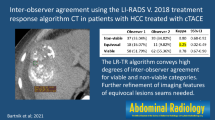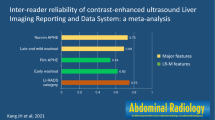Abstract
Purpose
To evaluate interreader and inter-test agreement in applying size- and necrosis-based response assessment criteria after transarterial embolization (TAE) for hepatocellular carcinoma (HCC), applying two different methods of European Association for the Study of the Liver (EASL) criteria.
Methods
Seventy-four patients (median age, 67 years) from a prospectively accrued study population were included in this retrospective study. Four radiologists independently evaluated CT data at 2–3 (1st follow-up, FU) and 10–12 (2nd FU) weeks after TAE and assessed treatment response using size-based (WHO, RECIST) and necrosis-based (mRECIST, EASL) criteria. Enhancing tissue was bidimensionally measured (EASLmeas) and also visually estimated (EASLest). Interreader and inter-test agreements were assessed using intraclass correlation coefficient (ICC) and κ statistics.
Results
Interreader agreement for all response assessment methods ranged from moderate to substantial (κ = 0.578–0.700) at 1st FU and was substantial (κ = 0.716–0.780) at 2nd FU. Inter-test agreement was substantial between WHO and RECIST (κ = 0.610–0.799, 1st FU; κ = 0.655–0.782, 2nd FU) and excellent between EASLmeas and EASLest (κ = 0.899–0.918, 1st FU; κ = 0.843–0.877, 2nd FU).
Conclusion
Size- and necrosis-based criteria both show moderate to excellent interreader agreement in evaluating treatment response after TAE for HCC. Inter-test agreement regarding EASLmeas and EASLest was excellent, suggesting that either may be used.
Key points
• Applying EASL criteria, visual estimation and bidimensional measurements show comparable interreader agreement.
• EASL meas and EASL est show substantial interreader agreement for treatment response in HCC.
• Agreement was excellent for EASL meas and EASL est after TAE of HCC.
• Visual estimation of enhancement is adequate to assess treatment response of HCC.



Similar content being viewed by others
References
Llovet JM, Real MI, Montana X et al (2002) Arterial embolisation or chemoembolisation versus symptomatic treatment in patients with unresectable hepatocellular carcinoma: a randomised controlled trial. Lancet 359:1734–1739
Lo CM, Ngan H, Tso WK et al (2002) Randomized controlled trial of transarterial lipiodol chemoembolization for unresectable hepatocellular carcinoma. Hepatology 35:1164–1171
Dhanasekaran R, Kooby DA, Staley CA, Kauh JS, Khanna V, Kim HS (2010) Comparison of conventional transarterial chemoembolization (TACE) and chemoembolization with doxorubicin drug eluting beads (DEB) for unresectable hepatocelluar carcinoma (HCC). J Surgical Oncol 101:476–480
Maluccio MA, Covey AM, Porat LB et al (2008) Transcatheter arterial embolization with only particles for the treatment of unresectable hepatocellular carcinoma. J Vasc Interv Radiol 19:862–869
Salem R, Lewandowski RJ, Mulcahy MF et al (2010) Radioembolization for hepatocellular carcinoma using yttrium-90 microspheres: a comprehensive report of long-term outcomes. Gastroenterology 138:52–64
Sacco R, Bargellini I, Bertini M et al (2011) Conventional versus doxorubicin-eluting bead transarterial chemoembolization for hepatocellular carcinoma. J Vasc Interv Radiol 22:1545–1552
Bruix J, Sherman M, Llovet JM et al (2001) Clinical management of hepatocellular carcinoma. Conclusions of the Barcelona-2000 EASL conference. European Association for the Study of the Liver. J Hepatol 35:421–430
World Health Organization (1979) WHO handbook for reporting results of cancer treatment. WHO, Geneva
Therasse P, Arbuck SG, Eisenhauer EA et al (2000) New guidelines to evaluate the response to treatment in solid tumors. European Organization for Research and Treatment of Cancer, National Cancer Institute of the United States, National Cancer Institute of Canada. J Natl Cancer Inst 92:205–216
Lencioni R, Llovet JM (2010) Modified RECIST (mRECIST) assessment for hepatocellular carcinoma. Semin Liver Dis 30:52–60
Shim JH, Lee HC, Kim SO et al (2012) Which response criteria best help predict survival of patients with hepatocellular carcinoma following chemoembolization? A validation study of old and new models. Radiology 262:708–718
Riaz A, Miller FH, Kulik LM et al (2010) Imaging response in the primary index lesion and clinical outcomes following transarterial locoregional therapy for hepatocellular carcinoma. JAMA 303:1062–1069
Prajapati HJ, Spivey JR, Hanish SI et al (2013) mRECIST and EASL responses at early time point by contrast-enhanced dynamic MRI predict survival in patients with unresectable hepatocellular carcinoma (HCC) treated by doxorubicin drug-eluting beads transarterial chemoembolization (DEB TACE). Ann Oncol 24:965–973
Forner A, Ayuso C, Varela M et al (2009) Evaluation of tumor response after locoregional therapies in hepatocellular carcinoma: are response evaluation criteria in solid tumors reliable? Cancer 115:616–623
Kamel IR, Liapi E, Reyes DK, Zahurak M, Bluemke DA, Geschwind JF (2009) Unresectable hepatocellular carcinoma: serial early vascular and cellular changes after transarterial chemoembolization as detected with MR imaging. Radiology 250:466–473
Malagari K, Alexopoulou E, Chatzimichail K et al (2008) Transcatheter chemoembolization in the treatment of HCC in patients not eligible for curative treatments: midterm results of doxorubicin-loaded DC bead. Abdom Imaging 33:512–519
Malagari K, Pomoni M, Kelekis A et al (2010) Prospective randomized comparison of chemoembolization with doxorubicin-eluting beads and bland embolization with BeadBlock for hepatocellular carcinoma. Cardiovasc Intervent Radiol 33:541–551
Lin M, Pellerin O, Bhagat N et al (2012) Quantitative and volumetric European Association for the Study of the Liver and Response Evaluation Criteria in Solid Tumors measurements: feasibility of a semiautomated software method to assess tumor response after transcatheter arterial chemoembolization. J Vasc Interv Radiol 23:1629–1637
Bonekamp S, Jolepalem P, Lazo M, Gulsun MA, Kiraly AP, Kamel IR (2011) Hepatocellular carcinoma: response to TACE assessed with semiautomated volumetric and functional analysis of diffusion-weighted and contrast-enhanced MR imaging data. Radiology 260:752–761
Galizia MS, Tore HG, Chalian H, McCarthy R, Salem R, Yaghmai V (2012) MDCT necrosis quantification in the assessment of hepatocellular carcinoma response to yttrium 90 radioembolization therapy: comparison of two-dimensional and volumetric techniques. Acad Radiol 19:48–54
Corona-Villalobos CP, Halappa VG, Geschwind JF et al (2015) Volumetric assessment of tumour response using functional MR imaging in patients with hepatocellular carcinoma treated with a combination of doxorubicin-eluting beads and sorafenib. Eur Radiol 25:380–390
Bankier AA, Levine D, Halpern EF, Kressel HY (2010) Consensus interpretation in imaging research: is there a better way? Radiology 257:14–17
Deodhar A, Brody LA, Covey AM, Brown KT, Getrajdman GI (2011) Bland embolization in the treatment of hepatic adenomas: preliminary experience. J Vasc Interv Radiol 22:795–799, quiz 800
Shim JH, Lee HC, Won HJ et al (2012) Maximum number of target lesions required to measure responses to transarterial chemoembolization using the enhancement criteria in patients with intrahepatic hepatocellular carcinoma. J Hepatol 56:406–411
Fleiss JL, Cohen J (1973) The equivalence of weighted kappa and the intraclass correlation coefficient as measures of reliability. Educ Psychol Measurement 33:613–619
Landis JR, Koch GG (1977) The measurement of observer agreement for categorical data. Biometrics 33:159–174
Memon K, Kulik L, Lewandowski RJ et al (2011) Radiographic response to locoregional therapy in hepatocellular carcinoma predicts patient survival times. Gastroenterology 141:526–535, 535 e521–522
Riaz A, Memon K, Miller FH et al (2011) Role of the EASL, RECIST, and WHO response guidelines alone or in combination for hepatocellular carcinoma: radiologic-pathologic correlation. J Hepatol 54:695–704
Bargellini I, Vignali C, Cioni R et al (2010) Hepatocellular carcinoma: CT for tumor response after transarterial chemoembolization in patients exceeding Milan criteria–selection parameter for liver transplantation. Radiology 255:289–300
Riaz A, Kulik L, Lewandowski RJ et al (2009) Radiologic-pathologic correlation of hepatocellular carcinoma treated with internal radiation using yttrium-90 microspheres. Hepatology 49:1185–1193
Kim BK, Kim KA, Park JY et al (2013) Prospective comparison of prognostic values of modified Response Evaluation Criteria in Solid Tumours with European Association for the Study of the Liver criteria in hepatocellular carcinoma following chemoembolisation. Eur J Cancer 49:826–834
Suzuki C, Torkzad MR, Jacobsson H et al (2010) Interobserver and intraobserver variability in the response evaluation of cancer therapy according to RECIST and WHO-criteria. Acta Oncol 49:509–514
Kubota K, Hisa N, Nishikawa T et al (2001) Evaluation of hepatocellular carcinoma after treatment with transcatheter arterial chemoembolization: comparison of Lipiodol-CT, power Doppler sonography, and dynamic MRI. Abdom Imaging 26:184–190
Loffroy R, Lin M, Yenokyan G et al (2013) Intraprocedural C-arm dual-phase cone-beam CT: can it be used to predict short-term response to TACE with drug-eluting beads in patients with hepatocellular carcinoma? Radiology 266:636–648
Acknowledgments
The scientific guarantor of this publication is Richard Kinh Gian Do. The authors of this manuscript declare no relationships with any companies whose products or services may be related to the subject matter of the article. One of the authors, Olivio F. Donati, received funding from the Swiss National Science Foundation and the Swiss Radiological Society. Junting Zheng and Chaya S. Moskowitz kindly provided statistical advice for this manuscript. Institutional review board approval was obtained. Written informed consent was obtained from all subjects (patients) in this study. Methodology: retrospective, cross sectional study, performed at one institution. Part of this research was funded by the National Institutes of Health through a core grant (P30 CA008748); we acknowledge the support of the MSKCC Biostatistics Core (P30 CA008748).
Author information
Authors and Affiliations
Corresponding author
Electronic supplementary material
Below is the link to the electronic supplementary material.
Supplemental Table 1
(DOC 32 kb)
Rights and permissions
About this article
Cite this article
Donati, O.F., Do, R.K.G., Hötker, A.M. et al. Interreader and inter-test agreement in assessing treatment response following transarterial embolization for hepatocellular carcinoma. Eur Radiol 25, 2779–2788 (2015). https://doi.org/10.1007/s00330-015-3677-4
Received:
Revised:
Accepted:
Published:
Issue Date:
DOI: https://doi.org/10.1007/s00330-015-3677-4




